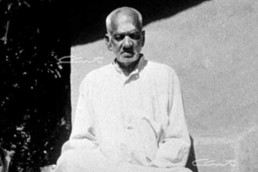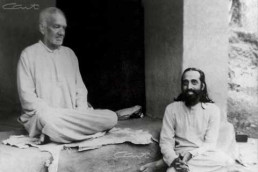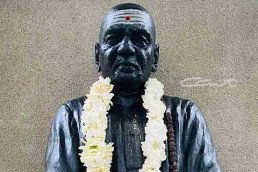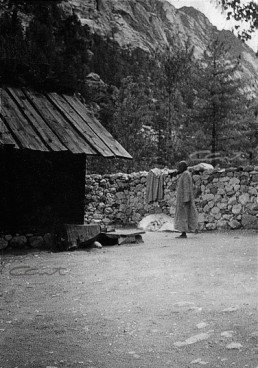
The Glory of Sri Gangottari
This is a free-flowing translation of the 108 verses in the first part of Gangottari Mahatmyam or ‘The Glory of Sri Gangottari’ by Sri Swami Tapovan Maharaj. These days many people go on a Char Dham Yatra and visit Gangottari. Their pilgrimage will be enriched by reading this outpouring by our Parama Guru Swami Tapovan Maharaj. The beauty of the Sanskrit verses can never be fully captured in English. And yet, for those of us who are not familiar with Sanskrit, this eminently readable article will at least give a glimpse of what our Swami Tapovanam has written.

The Glory of Sri Gangottari
This is a free-flowing translation of the 108 verses in the first part of Gangottari Mahatmyam or ‘The Glory of Sri Gangottari’ by Sri Swami Tapovan Maharaj. These days many people go on a Char Dham Yatra and visit Gangottari. Their pilgrimage will be enriched by reading this outpouring by our Parama Guru Swami Tapovan Maharaj. The beauty of the Sanskrit verses can never be fully captured in English. And yet, for those of us who are not familiar with Sanskrit, this eminently readable article will at least give a glimpse of what our Swami Tapovanam has written.
Once upon a time, in the huge assembly of Brahmaloka, graced by Lord Brahma (the creator) and other gods, and sages like Sanaka, there arrived Narada Muni, singing the glories of Gangottari and its magnificent beauty. Singing thus, accompanied by his melodious lute, he bowed down to the four-faced Lord Brahma with great devotion.
Brahmaji welcomed him and enquired about his welfare: “Please come and be seated here. I am seeing you after a long time. Hope all is well with you. Tell me about all the places you have visited in this time.”
Narada replied, “Roaming here and there in many worlds, finally I reached Gangottari, situated among the snowy peaks of the Himalayas. Covered with splendid forests and stately trees, arrayed with exotic flowers, the divine place resounded with the enchanting chirping of a variety of birds. Here it was that the river Ganga, originating from the holy feet of Lord Vishnu, descended from the heavenly regions and made herself visible to the eyes of human beings. Here shines the famous and sacred Bhagiratha Shila, on which Bhagiratha, the best among kings, stood in intense tapas for long. Having bathed in the holy Ganga there, and having worshipped her devoutly with a thousand names, I have come to you straight, singing the glories of Gangottari, the most excellent among holy places.”
Lord Brahma responded: “Blessed are you, O Sage! Having worshipped at the holy Gangottari tīrtha, your life is fulfilled forever. The place where Bhagiratha performed his penance is well-known in the three worlds. O Narada, know this sacred place to be a veritable Vaikuntha on Earth. There is no other place to match this in bestowing both prosperity and liberation. It is free from the evils of Kaliyuga and is the recreation ground of the holy Ganga. Hundreds of Śivaliṇgas and images of various deities are found here in abundance. Those pilgrims who visit this holy place and worship are indeed blessed, as it gives rise to pure sattva-guṇa. What a wonder that there is no sin, no corruption, no crookedness, no deceit, no hypocrisy, nor any sorrow here! It is a place of penance for ascetics and of contemplation for sages; it is the beloved abode of devotees and dispassionate ones. Rich it is with fruits, roots and tubers, endowed with many caves and thickets, serene, secluded and profound, a place fit for brahma-samādhi.”
“O Sire,” said Narada, “please tell me in detail the greatness of Gangottari and also how this name came about. O Grandsire of the entire world! Please tell me about the important places there that should be visited and worshipped. I wish to listen to all this directly from you, for who else except you knows it all!”
Lord Brahma said, “Well asked, O Sage! Listen to my words now. I shall tell you in brief about this holy secret that you have queried. The greatness of Gangottari is wondrous and awe-inspiring. It is not easily available even to gods. It should be guarded with great care. All kinds of people have obtained their desires and attained liberation by worshipping this holy place. It is well known that in Kaliyuga, when the minds of people are tainted by its typical flaws and laziness, there is no other means of attaining prosperity and liberation than the worship of the holy Ganga.”
“Even a glimpse of the holy Ganga is meritorious, so also a dip in her waters, living on her banks, chanting of her name and worship offered to her. Even a touch of the breeze sanctified by her waters can wash away one’s sins. The holy Ganga is the sole refuge in Kaliyuga for sinners who want to shed their sins, for those who want to fulfill their desires, for sufferers who want an end to their sorrows and for devotees who seek final liberation.”
“Verily, the supreme Brahman alone flows in the form of the river with the auspicious name of ‘Ganga’ in order to bestow upon man all the four puruṣārthas (dharma, artha, kāma and mokşa). The greatness of Ganga is more evident in the higher reaches. So, as far as possible, we should worship her at the higher altitudes.”
“How can the glory of Gangottari, the best among holy places, the peak of the northern region and the very birthplace of the holy river Ganga ever be described?”
“Since she came down to the earth, she became known as Ganga – gāṃ gatā hi tato gaṅgā. And now, on earth, her magnificent flow and terrific speed is wondrous indeed. The place where she flows northwards (uttara) is known as Gangottari. Or, since the heavenly Ganga came down from her abode, headed towards this spot, crossing over (uttarati) the outer space etc. it is called Gangottari. Or, O Narada, the place where the northern part (uttara) of Ganga shines forth is known as Gangottari. Or, the sacred place where the blessed Ganga alone is the supreme (uttara) deity, and none else, became famous as Gangottari. Or else, being the best means of crossing over (uttaraṇam) the ocean of saṁsāra, the region is known as Gangottari.”
Bhageeratha Shila
“O Son, now listen carefully about the important places worthy of worship situated in this great location. The best among them is the Bhageeratha Shila visited by you. King Bhageeratha did intense tapas there for 5500 years, eating only dry leaves. In this long period of time, an anthill formed around him. Pleased by his severe penance, I appeared before him and granted him the boon he desired. Ganga lives there along with Yamuna and is worshipped duly. These two beautiful glowing goddesses, one fair (Ganga) and the other (dark), appeared bedecked and bejewelled, with dangling earrings, in front of Bhageeratha, the grandson of Anshuman.”
“As of yore, today also they are visible in this sacred place to those great devotees who are dedicated to their lotus feet. There is no doubt about this. They are seen wandering among the forests full of deodar trees. Adorned with earrings and jingling golden waist-bands, smiling sweetly, lotus-eyed, seated on a golden throne, surrounded by many damsels, shaded with a white umbrella, fanned by Indra and other gods, the Mother of the three worlds, not easily attained by the denizens of the three worlds, resides here always with Yamuna, the daughter of the Sun-god. The abode of Ganga and Bhageeratha’s place of penance – great indeed is the sanctity of this Gangottari. Mortals attain immortality, absolved of all their sins, by bathing in the waters of the Ganga and worshipping her at this spot.”
“O Narada! This is the best place on earth to offer oblations to the ancestors. There is no time restriction for such rituals here; one can perform them in the day or at night. Whoever performs the rituals for their ancestors here, uttering their name and gotra, those ancestors, even if they be sinful, go to heaven.
“O divine sage, listen! Whoever makes offerings in fire for devas in this place, gets special rewards. The gold, silver, cows, grains and lands which are given to brāhmaṇas in charity at this place bear fruit immediately. There is no doubt that charity and other such actions performed here are a thousand times more fruitful than in holy places like Varanasi, Gaya, Haridwar etc. Where is Gangottari and where are Kashi and Gaya! Can a glow-worm shine in front of the brilliant sun? O Muni! Great tīrthas like Kashi assume divine forms and reside in this sacred place day and night to purify themselves.”
Gauri Kunda
“Behind the Bhageeratha Shila is Gauri Kunda of great sanctity and extraordinary beauty, which is visited by gods, and a mere glimpse of which is enough to destroy all sins.”
“The place where Kedara Ganga, flowing down from the peaks of Kedarnath, mingles with Jahnavi is a hallowed place. O Muni, it is wonderful to see the Ganga cascading down as a waterfall and to hear the deep reverberation of her continual thundering roar.”
“Goddess Gauri, surrounded by her companions, sports here; hence this place is known as Gauri Kunda. Lord Siva, the consort of Gauri, the lord of the universe, the leader of celestial beings, resides here along with his bhūta-gaṇas.”
“In this sacred place setutarpaṇa is to be performed. I shall tell you the method, listen carefully. The sand brought from Dhanushkoti is to be worshipped in the prescribed way with offerings of coconuts and sanctified with the chanting of Rudram etc. and offered in the Gauri Kunda devoutly by the best of ascetics. This is called setutarpaṇa and it is very meritorious. One who does the setutarpaṇa as specified, without any desires, is released from the cycle of births. There is no doubt about it. If it is performed with a specific desire, it is fulfilled soon. Whoever does setutarpaṇa thus is blessed indeed.”
“Listen further, O Muni! The water from the Ganga in Gangottari — carried by one who is pure internally and externally, who is devout and self-controlled, who walks on foot and follows the right values, who sleeps on the ground and eats very little — offered as ordained to the Sivalinga in Rameshwaram, installed by Sri Ramachandra in days of yore and worshipped by devatās, yields the state of Śiva-sāyujya to the one who does the abhiṣeka.”

Pandava Yajña Bhūmi
“Behind the Gauri Kunda is the sacred spot where the Pandavas performed yajña. A mere glimpse of it has the power to destroy all our sorrows. Following the advice and instructions of Sri Veda Vyasa, the Pandavas came to Gangottari to atone for the sin of killing their own kin. There, with due devotion and ordained rituals, they performed a deva-yajña with the help of brāhmaṇas. What a delightful place it is, vast and undisturbed! Even today, the residual ashes from the yajña can be seen there under the earth.”
“Nearby, see the Ganga gushing down from the mountain peak where reside the eleven Rudras. The great Gurus and those who have realised the Truth have thought well about how to elevate the mind attached to worldly thoughts gradually, step by step, effortlessly, and have invoked the appropriate devatās in the tīrthas. And these Rishis themselves resided in those places and worshipped them for the welfare of the people.”
Rewards of Pilgrimage
“When worship of the fire and tapas is not performed any more in this world, how will the weak mortal attain material welfare and ultimate liberation? Selfless worship of the divine Ganga destroys the accumulated sins of many lives and gives rise to great merits. Then likes, dislikes and other flaws of the mind are removed and then devotion for the Lord and (spiritual) knowledge is born. Even those who are not qualified for it attain such devotion and knowledge effortlessly.”
“The main result of all the pilgrimage, penance, self-study, worship, singing the praise of the Lord is the attainment of liberation; others are ancillary benefits. Just as children are lured by jaggery, the dull and worldly-minded people are given specific rewards as incentives to pursue virtuous actions. All the worldly pleasures seem desirable, but wise people do not desire them because they are impermanent and tainted by sorrow. Who, except fools, will undertake arduous pilgrimages for the sake of ephemeral gains?! The only reward we seek should be to please God and gain devotion which can release us from the miseries of the world.”
“’Bhagavan is the lord of the entire world and full of compassion for the devotee; I am but a worldly jīva, an insignificant servant of His.’ With such duality in the intellect, the wise one begins worship of the Lord and attains the non-dual vision of the Lord in everything. The realisation that all is Brahman is the only actual means to liberation. Alas! Who attains it easily here? Until the continual unbroken knowledge of ‘All is Brahman,’ does not come about, the finite thought of ‘This is Brahman,’ is prescribed. ‘All this, moving and non-moving is pervaded by Īśvara,’ – such firm knowledge arises only with the practice of many lifetimes.”
“How can one who is unable to worship a gross form like a river or a stone idol worship the essential Truth of Īśvara which is subtler than the subtlest? Places endowed with natural beauty and other such fascinating things are worth seeing and contemplating upon. Holy places of pilgrimage are meant to make the mind that is extroverted and scattered among sense objects turn towards God. Even the contemplation on God with a form is difficult and hence a concrete symbol has to be given to those with a (spiritually) dull intellect. Somehow or other the roving mind that is tenaciously moving everywhere moment to moment has to be restrained and made single-pointed. Even a mind that is full of sinful thoughts should be made to entertain good thoughts through conscious effort, and then made thought-free. The Lord knows the thoughts and feelings of all people, and bestows the appropriate results to them.”
“Some people purify their hearts by adoring sacred places or worshipping deities like Rama or Krishna, others through japa, tapa, prayers or singing of hymns, yet others by self-study or contemplation on the scriptures. Some prefer to do prāṇāyāma and some others resort to meditation. Some do it by performing rituals or selfless actions, some by doing charity or service to mankind. Thus, without any desires, they worship God and purify their minds.”
“How can an impure mind agitated with hundreds of thoughts attain the state of thoughtlessness? Only a pure single-pointed mind capable of subtle thinking can come to know the highest Truth that is beyond the reach of the mind and the senses.”
Continued …
Narada Muni said, “O Brahmaji! With your grace, I have been able to hear about the incomparable and mystical glory of Gangottari. Now, O Lord, with a fatherly affection, please tell me the distinctive features of the other places in the region.”
“O Narada, listen about the other holy places, a mere glimpse of which can destroy hundreds of sins,” said Lord Brahma. “You are dear to me, you are my son, and hence I will tell you about the secret glory of these places, which are rare to find in the three worlds, and that delight the hearts of good people.”
Lakshmi Vanam, Devaghat and Bhurjavasa
“O Sage! There shines right ahead Lakshmi Vanam1, the playground of Mahalakshmi, full of fruit-bearing trees. Further ahead is the confluence of Devi and Ganga.2 This is the abode of gods, and mortals cannot reach there. To the east is the beautiful Bhurjavasa, an expansive forest full of mighty birch trees. Blessed is he who can set eyes on this divine place worshipped by celestial sages, yakşas, gandharvas, siddhas and cāraṇas.3”
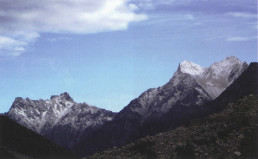
Pushpavasa, Gomukha and Suryakunda
“Beyond this, O best among sages, lies the vast garden of flowers called Pushpavasa, full of many varieties of ambrosial blossoms. There is Gomukha, the hallowed birthplace of the divine Ganga, holier than the holiest on earth, extolled by sages in many hymns. It is surrounded by high snow-covered peaks almost touching the heavens and presided over by gods. In that place, bedecked with masses of snow, a veritable jewel on earth, from a deep snowy cave, shaped like the mouth of a cow, emerges with tremendous force the celestial river Ganga, to purify and bless all beings on earth. Those who manage to reach that extremely inaccessible, divine cave, and bathe in the waters of the Ganga in the prescribed manner will have no more re-birth, O Son! There need be no trace of doubt about it. Understand this, for you are very dear to me.”
“One who dips himself in the bluish waters of the famous Suryakunda in Gomukha begins to glow like the sun. The mountain ranges beyond this are perpetually covered with heavy snow and are inaccessible to human beings. Not far from Gomukha is Vishalapur4 and the route there is frequented by siddhas and devatās.”
Sri Narada Muni beseeched him thus, “O Lord of the worlds! Please describe in detail the glory of Gomukha, the birth- place of Jahnavi.”

More about Gomukha
Lord Brahma responded, “Dear Narada, listen carefully. I shall answer your query about the sublime splendour of Gomukha that should ever be cherished and guarded. Gomukha, praised by the gods, is the sportive ground of Sri Lakshmi herself. Since this cavern in the snow is shaped like the mouth of a cow, it bears the name ‘Gomukha’. Lit up on all sides by the bright snowy peaks, donning ornaments made of masses of snow, she delights the mind in the daytime with the silver sheen of the ethereal mountain peaks and in the evening with their golden glow, making one wonder whether the mountains are made of silver or gold!”
“Gomukhi is divine and spreads her ethereal effulgence all over the vast expanse of space. She shines as the central gem in the crown jewel of the Himalayas. It is a place that is worshipped by gods and is not easily attained even by them. Great is the puṇya of the virtuous ones who are able to set eyes on it. It is deep and inaccessible, and devoid of vegetation. It is supremely tranquil and profound, magnificent and carpeted with stones and pebbles.”
“To add to its beauty, there is a forest of birch trees nearby. A variety of birds of many hues chirp melodiously. Spread all around are flowers – blue, red, white and yellow, fit to adorn the locks of Indrani (consort of Indra). Musk deer and a variety of other wonderful animals roam about free and fearless.”
“Who can ever describe the exquisite beauty of the place! Even Indra with a thousand eyes never tires of looking at it. O Sage! Not merely is this place the source of joy for the senses, but it is also the crest jewel of all tīrthas (holy places of pilgrimage). By going there even once and having darśana, all one’s sins will be rooted out and one will get the desired results. At the touch of a single drop of the water of Ganga there, one attains the abode of gods, irrespective of where one lives. O Muni! Lord Vishnu, Siva, Indra and I have worshipped this tīrtha with śraddhā (total faith and dedication) many a time. When the best of seekers go there, they are irresistibly drawn by its divine beauty and get immersed in the contemplation of Brahman. Those who have analysed the matter say that the knowledge of the effect results in knowledge of the cause. Thus, by seeing the glory of Nature there, Brahman, the cause of it, comes to mind. At the sight of a magnificent palace, its architect is remembered. In the same way, seeing the awe-inspiring and divine beauty of Nature untouched by man, one remembers God, its creator. What wonder then if virtuous people get immersed there in thoughts of God?”
“Beauty is the nature, the very essence of God. And hence it is seen in Nature also. Beauty is not the essential quality of Nature by itself. Brahman, the seed of this world, is the Truth of truths, the Consciousness of all that is sentient, and the Beauty of beautiful things. Thus, through the window of Nature, Brahman alone bestows joy to all as they deserve. The wise ones who have the profound knowledge of Brahman see clearly that all this glory belongs to Brahman, and it is not Nature’s own radiance. Such wise people, overwhelmed by the divinity of such places where the beauty of Brahman shines forth, attain the supreme state of oneness with Brahman spontaneously. O Sage! Great is the merit bestowed by the darśana of Gomukha! Only a pure and blessed soul attains it.”
“The darśana of Gomukha and a holy dip there gives devotees wonderful rewards here and hereafter. What more needs to be said? Listen to this secret of secrets. There is no other tīrtha like Gomukha on this earth.”
“O best among sages! Whichever places I have described to you are all worthy of being worshipped by all mortals. Besides these, the other most blessed places that are there below, I shall describe. Listen carefully with devotion.”
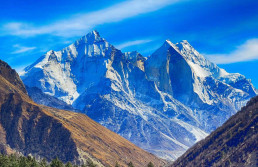
Other Places of Pilgrimage near Gomukha
“Below the Gaurikunda is the wonderful abode of Sri Bhairava. The formidable and powerful form of Sri Bhairava is to be worshipped there. Further down is the mystical and utterly charming spot where the dark-hued Jahnu Ganga joins Sri Gangaji. O best among sages! Those who go upward along the banks of Jahnu Ganga will come across many divine tīrthas that destroy their sins.”
“The actual dwelling place of Lord Siva (Mt. Kailas), darśana of which destroys the cycle of saṁsāra, is approached through this route by some people.6 O Sage! Nearby is the hermitage of Sri Jahnu Rishi, where the kingly sage performed severe penance.7 A little below this is the charming stream named Kumkum on whose auspicious banks Sri Veerabhadra resides.8 Alongside is the important place where Mahadevi Chandeshwari, the destroyer of Chanda and Munda resides. In the same region flows the delightful stream, well-known as Deva Ganga,9 which is worshipped by gods and which bestows great merit.”
“O Narada! Behind this stream, near the vast sands of the river Ganga is the place of Markandeya that is worth seeing. Matanga Rishi, the best among sages, had observed austerities for many years nearby, living only on air, and attained Realisation. While proceeding to Gangottari, Yudhishthira and the other Pandavas spent many nights there and worshipped Mother Ganga. Brought by the son of Vayu (Bheema), a big stream flows by with great force like the wind, sanctifying all in its path.10 See the wondrous imprints of the hooves of the Pandava horses on the rocks here! Only virtuous people with great merits (puṇya) can see these. This place bestows all kinds of wealth and is the stepping-stone to the supreme Truth. This is the favourite abode of Mother Ganga and is also beloved of the gods.”
“Among all the monasteries on the earth, this abode of Ganga is known to be the best.11 Meritorious deeds performed at this place where Markandeya did tapas will fetch results similar to the deeds undertaken at the place where Bhageeratha performed his penance. Actions prescribed by the sāstras, like bathing, offering oblations to the ancestors, charity etc. done here bring wonderful and desired results to those who perform them. The mere sight of the huge rock used by Sage Markandeya (for his tapas) has the power to destroy crores of earlier karmas. Distribution of food and clothes in this place is considered to be especially meritorious. Brāhmaṇas and others are to be seated on that huge rock and fed in the prescribed manner to their satisfaction. Whoever spends a night in Markandeyapuri in the revered presence of Mother Ganga will surely attain Sivaloka. Great sages, ascetics, those devoted to the lotus feet of Mother Ganga and the dispassionate ones choose to live here.”
“O Son! Not far is the incomparable and divine place where the consort of Lord Siva, the mother of the entire universe and the goddess of all, took birth as the daughter of Himavan after giving up her form as Sati in the Daksha-yajna.” 12
“See the tīrtha named Hariprayag situated nearby.13 Even a person with evil propensities attains the abode of Vishnu by bathing there. Another mysterious place, not well-known on this earth, is Guptaprayag,14 which can destroy the secret sins of seven generations before and after the person who immerses himself in its waters.”
“O Son! Behold the confluence of the radiant waters of the Bhageerathi with the dark waters of Shyamaganga and the vast and divine sand banks there. Seeing, touching and bathing in the waters here increases by leaps and bounds one’s treasure of Brāhmic knowledge. Hence, all these tīrthas are to be worshipped as prescribed.”
“On the left bank of the Ganga is situated the great and beautiful Vishvanathapuri, where dwells Lord Vishveshwara Himself.15 Here flows in the northern direction the auspicious stream well known as Hatyaharini, originating from the Shrikantha mountain. One who spends a night here in devotion after bathing in the three-fold confluence (of Bhageerathi, Devaganga and Hatyaharini) will find his worst sins destroyed.”
“In the same area is the confluence of the Ganga with Ksheera Ganga, where a person desirous of prosperity should bathe. On both banks of the Ganga are many holy water currents that can confer puṇya.”
“O Sage! Behold above it the resplendent peak of the Shrikantha mountain, the veritable abode of Lord Siva, visited by Vishnu and other gods. All these magnificent places are the holiest of holy on this earth, where sages love to reside and Ganga Devi revels in merriment.”
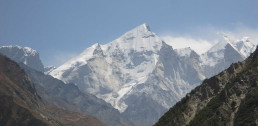
“O Sage! How can one ever do full justice to the description of the glory of Ganga and Gangottari? After obtaining a human form, one who does not perform virtuous actions related to the transcendental world lives a meaningless life like a crow. Except for a human being, which other creature is capable of reflecting on matters like this: ‘The ātma is different from the body. What happens to it after the death of the body?’ A person whose only goal is to derive greater enjoyment from food, sex etc. is to be considered animal, not a human being. One who has obtained the human form should think of what is good and what is bad and always proceed intelligently along the path that is good for him.”
“The greatest good of all that is good is firm abidance in Brahman. By giving up attachment to things and by the grace of Mother Ganga, one can attain it. Where there is no limitation of time, space etc. and no differences like ‘I’ or ‘You’, nor the duality of the ‘enjoyer’ and ‘object of enjoyment’ etc., that is the highest state of Brahman. Where there is no sun, moon or stars and no day or night, which is neither void nor non-void, that wondrous state is Brahman. That which is neither male, female nor neutral, neither with form nor formless, neither like that nor like this – that is Brahman.”
“Brahman is Truth, all else is untruth (unreal), like a dream, and not other than Brahman. This world is an appearance because of the illusion of time, place etc. The firm and direct knowledge that everything is actually Brahman alone is to be understood as the highest goal of man, one that showers the greatest bliss. Those who lack discrimination consider things which give trivial joy like women,16 gold etc. to be the highest goal.”
“As a result of past impressions (vāsanās) one may be with desires or without desires. However, by worshipping the goddess Ganga with dedication, one attains the highest state. The highest Truth is one alone, known by different names as Brahman, Īśvara, Puruşa, Siva, Vishnu, Ganga etc. In this illusory world what essence or truth is there other than Īśvara to be prayed for? Even then, out of delusion, people pray for things.”
“People should develop devotion for the Lord somehow or the other. Those who love wealth should use it to serve Him alone. The Lord grants all our desires, like the kalpataru (the wish-fulfilling tree). In whom can man17 take refuge, if not in that all-powerful Lord!”
“I am the creator of this world and my creator is the Lord who bestows all fruits of actions, the all-knowing one seated in all intellects. If power is not separate from the powerful, then Ganga is the form of the Lord alone. Mortals should take refuge in that Mother for the fulfilment of their desires.”
“Whoever reads or hears this conversation of ours about the most sanctifying Gangottari tīrtha will also attain the highest state. Bless you my son! And may the world be blessed forever!” Thus, having blessed everyone, Brahmaji became silent.
“O Ganga! O Mother! Prostrations to you! O Ganga! O Mother! Prostrations again and again! You purify the fallen and purify the pure ones too!” Thus singing the glory of Ganga Devi again and again, and prostrating to his father Brahmaji, Sri Narada left the great assembly. “Prostrations to Thee, O Fortunate One! Follower of Bhageeratha’s chariot! Prostrations to Thee, the Mother of the world! O Ganga who flows on three routes!”
This glory of the abode of the Universal Goddess Ganga, composed with the inspiration of Sri Vishveshvara, is dedicated to Lord Vishveshvara Himself. May this always please Lord Vishveshvara!
1 Also known as Ganga Gardens.
2 Locally, it is called Devaghat.
3 Variety of celestial beings.
4 Badripur.
6 This route to Mt. Kailas is known as Neelang Pass.
7 This is the place called Jangala.
8 This stream is locally known as Gungum Nala.
9 The local name is Devaghat.
10 This is called Bheemdhara.
11 Hence it is known as Mukhimatha.
12 The place is called Kachora in local parlance.
13 This is well-known to pilgrims as Harsal.
14 The local name is Kuptighat.
15 This is famous as Gharali.
16 The word ‘women’ merely refers to the joys of sex in this context. No gender discrimination is intended. Similarly, gold refers to all kinds of material wealth.
17 The word ‘man’ refers to human beings all through this composition.
Previous Topic
Mandukya Upanishad
Swami Tapovan Maharaj sent this message to our Pujya Gurudev, Swami Chinmayananda, on the occasion of his Jnana Yajna on the…
Next Topic
Reminiscences
In this article Pujya Gurudev fondly shares some memories of his Guru, Swami Tapovan Maharaj. This article was published in…
Home Page
Homage to Sri Swami Tapovanam
The 50th anniversary edition of Tapovan Prasad (December 2011) was entirely dedicated to our Paramaguru Swami Tapovan…
